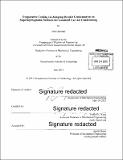Evaporative cooling via jumping droplet condensation on superhydrophobic surfaces for localized car air conditioning
Author(s)
Queeney, John (John Keeler)
DownloadFull printable version (4.565Mb)
Other Contributors
Massachusetts Institute of Technology. Department of Mechanical Engineering.
Advisor
Evelyn N. Wang.
Terms of use
Metadata
Show full item recordAbstract
Car air conditioning systems cool the entire cabin, which is inefficient, as only the air surrounding the passengers needs to be cooled to realize a similar effect. These air conditioning units draw large amounts of power, enough to be detrimental to fuel efficiency. This presents problems for cars with smaller engines and electric cars that lack the battery capacity to provide adequate cooling with traditional air conditioning technology. A novel solution to these problems uses evaporative cooling via jumping droplet condensation on superhydrophobic surfaces to provide localized cooling with 100 times less power input. Jumping droplet condensation takes place when microscale droplets coalesce on superhydrophobic surfaces and excess surface energy is converted to kinetic energy, resulting in droplets that jump perpendicularly off the surface. As these droplets fall through the air, they evaporate, cooling the surrounding air and providing localized cooling. To test this technology, a prototype device was designed, fabricated, and tested at different relative humidities in an environmental chamber. Cooling of up to 4.8°C relative to ambient was achieved at 80% relative humidity, 4 cm from the condensing surface. This result suggests an optimal humidity for the operation of these devices and prompts further lines of study for the optimization of this technology.
Description
Thesis: S.B., Massachusetts Institute of Technology, Department of Mechanical Engineering, 2015. Cataloged from PDF version of thesis. Includes bibliographical references (pages 28).
Date issued
2015Department
Massachusetts Institute of Technology. Department of Mechanical EngineeringPublisher
Massachusetts Institute of Technology
Keywords
Mechanical Engineering.